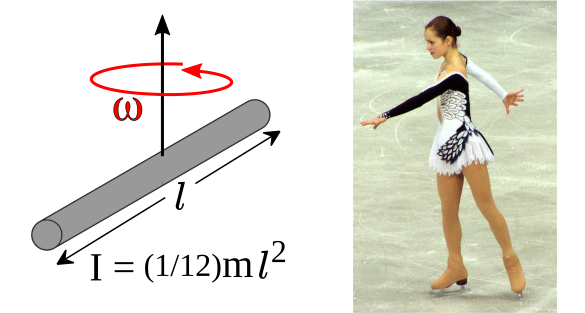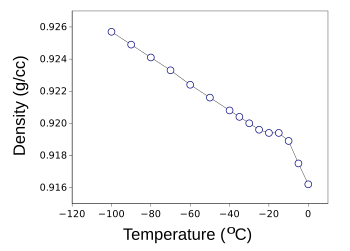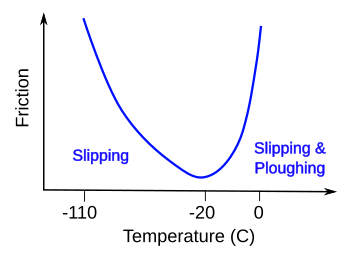Slippin' and Slidin'
March 29, 2021
Ice skating has given us some easily understood examples of a few
physical principles. The principal one, of course, is the concept of the
conservation of angular momentum. As often seen in
performance, when a
rotating figure skater with
arms extended pulls her arms inward, her
rotational speed increases. Her
moment of inertia I is decreased when her arms are placed inwards, so the rotational speed
ω is increased in order to keep a constant
angular momentum L; viz.,
L = Iω

Figure skating example of the conservation of angular momentum. The closest example to the relevant moment of inertia for a skater who uses the movement of her arms to change her inertia is that of a cylinder rotating about its center, as shown on the left. The moment of inertia L of an idealized case for a cylinder of mass m and length ℓ is L = (1/12)mℓ2. Since the length appears as a square, the change of inertia with length is large. The factor of (1/12) appears strange at first, but it's just a consequence of an integration of point masses along the cylinder. Shown on the right is American figure skater, Sasha Cohen (b. 1984), the 2006 Olympic silver medalist, preparing for a spin. (Left, a modified Wikimedia Commons image by Krishnavedala. Right image, Sasha Cohen at the qualification program at the World Figure Skating Championships, 2004, in Dortmund, by Uwe Langer. Click for larger image.)
Although the
icy surface of a
skating rink looks like
glass, you can't skate on glass because of
friction. The
coefficient of friction depends on what
materials are
rubbing against each other. The coefficient of
dynamic friction between the material "couple" of
iron or
steel on glass is a little more than 0.5,[1] but that for steel on ice is less than a tenth of this value. What makes ice so slippery?
While it's apparent that a
lubricating layer of
liquid water is responsible for the low friction, the method by which this layer forms has been
debated for more than a
century. In one
theory, the initial friction of the
skate blade heats the ice to
melt it.[2-3] In another, it's the
pressure on the blade that causes the melting. This is an expected consequence of the fact that ice is less
dense than water. A
transformation from ice to liquid water reduces the
volume and increases the
temperature according to the
Clausius–Clapeyron relation for ice,
(∂P/∂T) = -13.5 mPa/K = 1958 psi/°C
in which P is the pressure, and T is the temperature. It's good that skate blades are
sharp, since an ice layer 5
°C below
freezing needs 10,000 psi (
pounds per square inch) for melting. For most other materials, the volume increases upon melting, so increased pressure will increase the melting point. A good
review of the
physics of ice skating can be found at ref.4.[4]
A team of
physicists from the
University of Amsterdam (Amsterdam, Netherlands) has just
published an
open access paper in
Physical Review X in which they report on their ice
experiments.[5-6] They show that the
hardness of ice decreases with increasing temperature; and, when the ice hardness is below the
contact pressure of a pressed
sphere, how the sphere will undergo increased friction by
ploughing the surface. This ploughing action causes a temperature increase that further decreases the hardness.[5] They find that the ease of sliding on ice has a strong dependence on temperature, contact pressure, and
speed.[5-6]

Density of ice as a function of temperature.
Although liquid water expands as it freezes into ice, from that point ice behaves as most solids by becoming denser as temperature decreases.
(Data from the Engineering Toolbox, graphed using Gnumeric. Click for larger image.)
Previous
research put an emphasis on the layer of water layer interposed between the sliding object and the surface of the ice, but this layer alone doesn't explain why friction is higher near the melting point of ice.[6] The
Netherlands'
researchers did experiments in a temperature range from -120 to -1.5 °C on a very
smooth ice surface prepared by repeatedly adding a fresh water
film, effectively doing a
Zamboni treatment.[5-6] They
measured the friction using a
rheometer with different slider
shapes - a large sphere, a small sphere, and a shape similar to a skate blade.[5-6] They also measured the hardness in a manner similar to the
Rockwell method.[5-6]
The ice friction follows an
Arrhenius law behavior at temperatures far below its melting point.[5] Although its hardness decreases near the melting point, ice is still hard enough for sliding.[5-6] This performance is different from that of most other materials, which become soft near their melting point and don't allow easy sliding.[6] Near the higher friction
regime of ice near its melting point, blades penetrate this softer surface and start to plough through it.[5-6] The different shapes start to plough at different temperatures, with the small sphere ploughing at about -20°C, and the skate blade shape ploughing at -8°C because of its lower contact pressure.[6] The experiments also showed that the ice hardness increases with slider speed; so, a fast skate should plough less and thus slide better.[6]

Slipping and ploughing regimes for ice.
As the temperature is increased towards melting, a point will be reached where the ice hardness is below the contact pressure of the slider. At that point, the slider will plough though the ice surface, causing more friction.
(Created using Inkscape.)
"Slippin' and Slidin'" is a 1955
song co-written and
performed by
Little Richard (Richard Penniman (1932-2020)) and
released in other versions in subsequent years.[7]
References:
- D. H. Buckley, "Friction behavior of glass and metals in contact with glass in various environments," NASA Technical Note NASA-TN-D-7529, December 1, 1973 (PDF file).
- B. N. J. Persson, "Ice friction: Role of non-uniform frictional heating and ice premelting," The Journal of Chemical Physics, vol. 143, no. 22 (December 8, 2015, DOI:10.1063/1.4936299. A PDF file is available here
- Anne-Marie Kietzig, Savvas G. Hatzikiriakos, and Peter Englezos, "Physics of ice friction," Journal of Applied Physics, vol. 107, Article no. 081101 (April 26, 2010), https://doi.org/10.1063/1.3340792.
- Federico Formenti, "A Review of the Physics of Ice Surface Friction and the Development of Ice Skating," vol. 22, no. 3 (June 20, 2014), pp. 276-293, https://doi.org/10.1080/15438627.2014.915833. A PDF file can be found here
- Rinse W. Liefferink, Feng-Chun Hsia, Bart Weber, and Daniel Bonn, "Friction on Ice: How Temperature, Pressure, and Speed Control the Slipperiness of Ice," Phys. Rev. X, vol. 11, no. 1 (February 8, 2021), Article no. 011025, https://doi.org/10.1103/PhysRevX.11.011025. This is an open access article with a PDF file here.
- Karlis Agris Gross, "A Penetrating Look at Ice Friction," Physics, vol. 14, Article no. 20 (February 8, 2021).
- Little Richard, "Slippin' and Slidin' (Peepin' and Hidin') (1957)," YouTube Video by Classic Mood Experience, June 22, 2013.
Linked Keywords: Ice skating; physical property; physical principle; conservation of angular momentum; performance; rotation; rotating; figure skating; figure skater; arm; rotational speed; moment of inertia; angular momentum; inertia; cylinder rotating about its center; cylinder (geometry); mass; length; exponentiation; square; integration of point masses along the cylinder; American; Sasha Cohen (b. 1984); Winter Olympic Games; silver medal; silver medalist; figure skating spin; Krishnavedala; qualification; World Figure Skating Championships, 2004, Dortmund; Uwe Langer; ice; icy; surface; ice rink; skating rink; glass; friction; coefficient of friction; material; rubbing; dynamic friction; iron; steel; lubrication; lubricate; liquid; water; debate; century; theory; skate blade; heat; melting; pressure; density; dense; phase transition; transformation; volume; temperature; Clausius–Clapeyron relation; sharp; Celsius; °C; melting point; freezing; pounds per square inch; review article; physics; physicist; University of Amsterdam (Amsterdam, Netherlands); scientific literature; published; open-access journal; open access paper; Physical Review X; experiment; hardness; contact mechanics; sphere; plough; ploughing; speed; density of ice as a function of temperature; density; ice; function (mathematics); liquid; water; expansion (geometry); freezing; freeze; solid; data; Engineering Toolbox; Cartesian coordinate system; graph; Gnumeric; research; Netherlands; researcher; surface roughness; smooth; coating; film; ice resurfacer; Zamboni; measurement; measure; rheometer; shape; Rockwell scale; Arrhenius equation; Arrhenius law; regime; plough; ploughing; pressure; surface; Inkscape; Slippin' and Slidin'; song; composer; co-written; performed; Little Richard (Richard Penniman (1932-2020)); Little Richard discography.